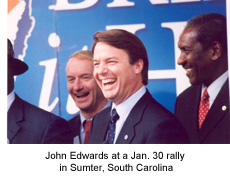Campaign Diary home >> A Witness to Two Americas
A Witness to Two Americas
 Date: Sunday, January 31, 2004
Date: Sunday, January 31, 2004
Location: Seneca, South Carolina
As I drive through Seneca, I see all the trademarks of small-town America. A doctor's family practice. A corner law office. Milton and Greg's Barber Shop.
Seneca is unusual only because it is the birthplace of John Edwards.
With its native son in Oklahoma today, I eat dinner at the Ye Old Sandwich Shop and talk with locals about their native son.
Most people in Seneca are Republicans, but Edwards' working-class background makes him appealing.
Swain Still tells me, "If you never grew up in a small town, you'd never know how to relate."
My waitress adds, "I know he can relate to what it's like around here."
Ernest likes that Edwards went to school close to home, and he adds with disapproval, "the rest of 'em come out of Yale."
As I leave Seneca, I think of Edwards' stump speech. Behind the charm of an affable messenger there lies a very serious message.
Two Americas. One rich, one poor. One black, one white.
Sadly in South Carolina, I see evidence of Edwards's "Two Americas" everywhere, especially on race.
I've been to Bob Jones University. The school remains unapologetic for its previous ban on interracial dating.
I've been to Maurice's Bar-B-Q. The state's most famous restaurant sells books like "Myths of American Slavery" and "Honest Abe Wasn't Honest."
I've driven past Calhoun Street, and Wade Hampton Avenue, and Strom Thurmond Boulevard. I remember the racist causes that those South Carolinians once defended.
Two Americas. One white, one black.
Here in South Carolina, I hear about "old money." What I mainly see is "old poverty."
Plants are closing. Jobs are leaving. People are struggling.
Two Americas. One rich, one poor.
John Edwards is more than a native son of the Carolinas. He is a product of the Carolinas, a witness to two Americas.
Next stop: Aiken, S.C.
Read previous dispatch






